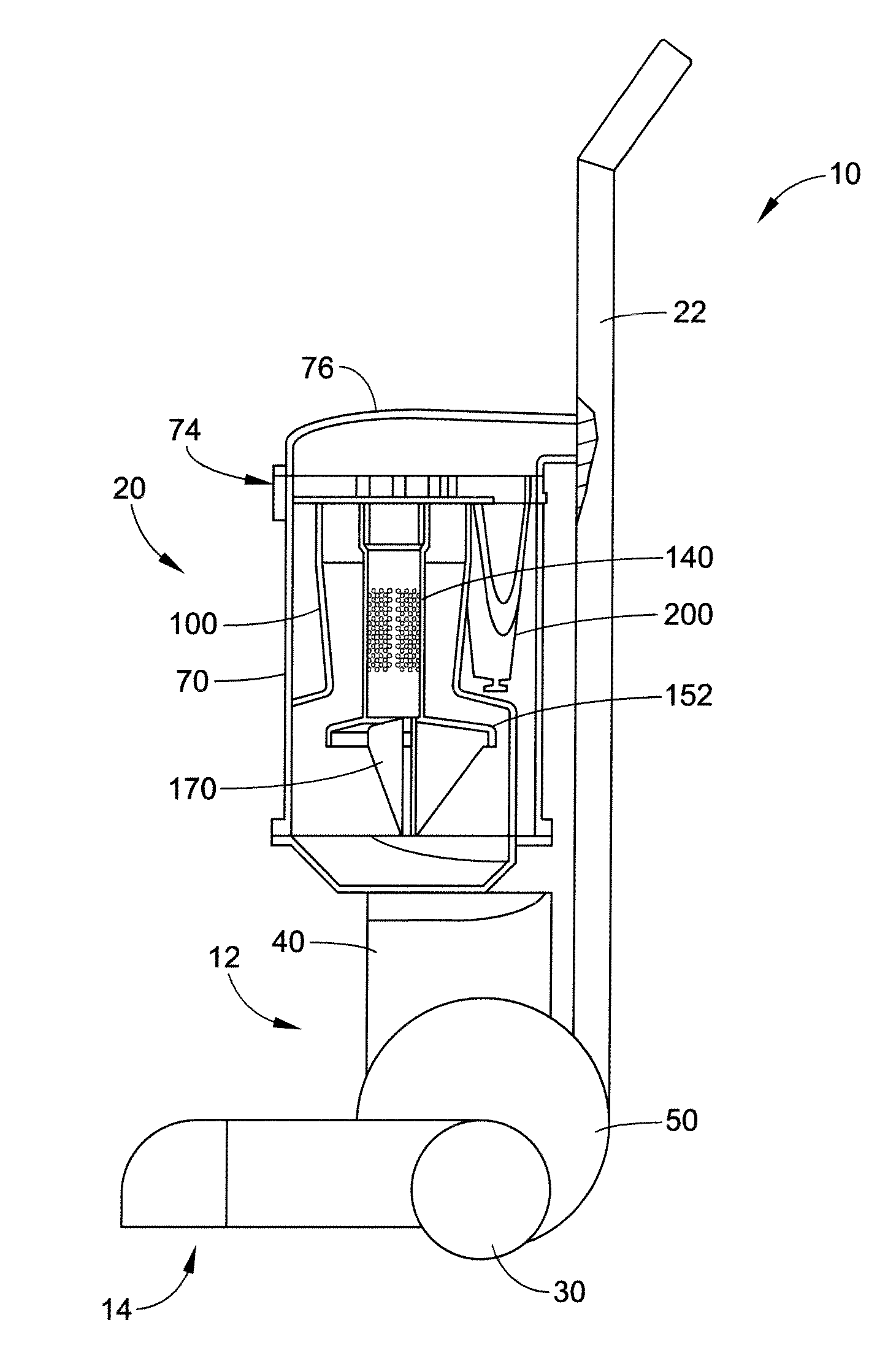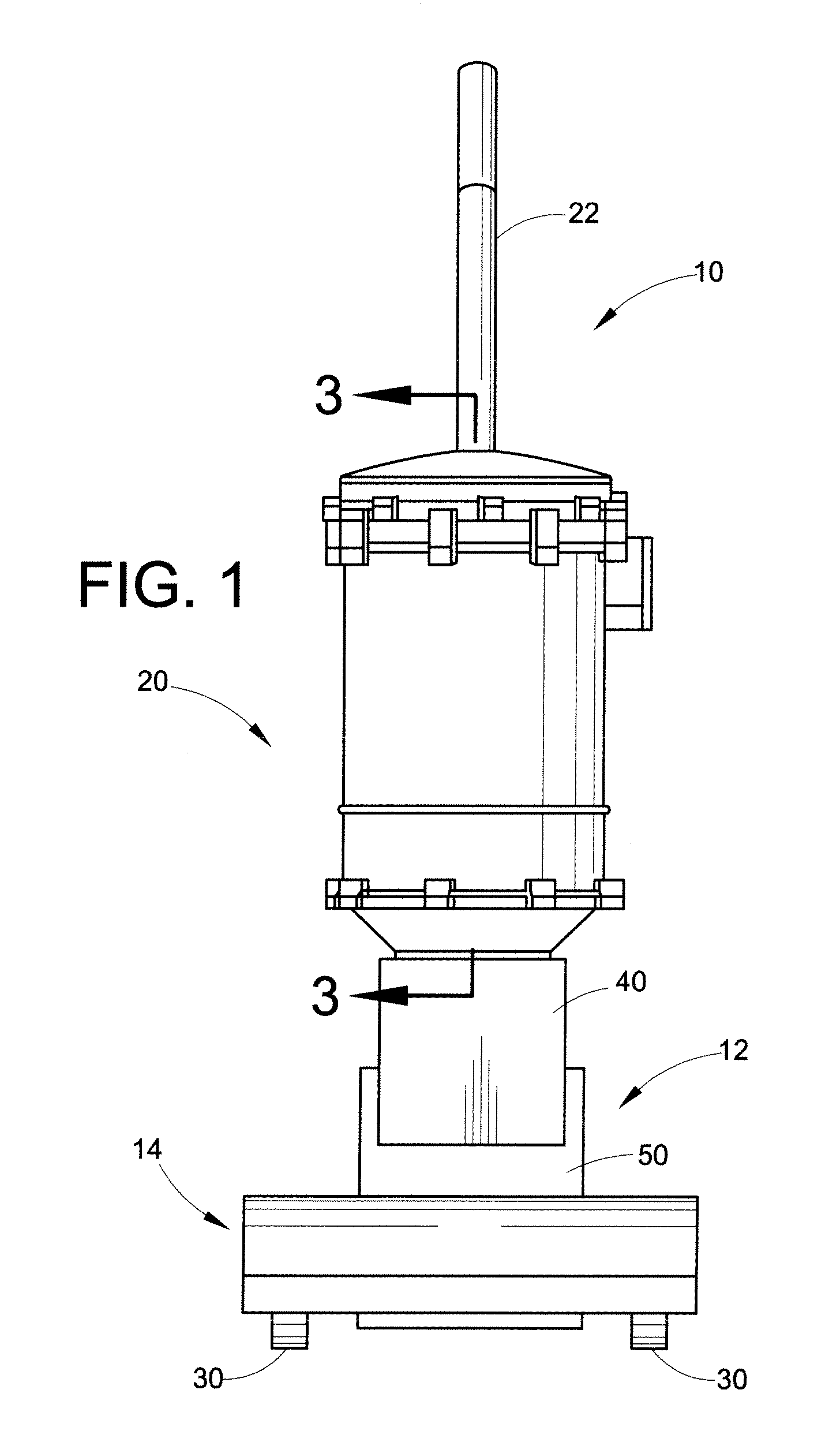Dual stage cyclonic vacuum cleaner
a vacuum cleaner and cyclonic technology, applied in vacuum cleaners, cleaning filter means, vortex flow apparatus, etc., can solve the problems of increasing the overall height of the dust collector, increasing the overall width of the particle collector, etc., and achieves the effect of better and more advantageous overall results
- Summary
- Abstract
- Description
- Claims
- Application Information
AI Technical Summary
Benefits of technology
Problems solved by technology
Method used
Image
Examples
second embodiment
[0048]Connected to a lower, closed end 150 of the perforated tube 140 is a shroud 152 for retarding an upward flow of dirt and dust particles that have fallen below the lower end 108 of the first stage separator 100. Details of the perorated tube and shroud will be described below with respect to the dust collector.
[0049]A laminar flow member, such as one or more baffles or fins 170, is mounted to one of the shroud 152 and the closed lower end 150 of the perforated tube 140. At least a portion of the laminar flow member is encircled by the shroud 152. The laminar flow member extends partially into the first dust collection chamber 82 and is positioned centrally within the first dust collection chamber. As shown in FIG. 5, the depicted baffle 170 can be cruciform in shape and include a cross blade assembly, which can be formed of two flat blade pieces that are oriented approximately perpendicular to each other. It should be appreciated that the baffles 170 are not limited to the conf...
first embodiment
[0063]Similar to the first embodiment, the first and second dust collection chambers 340, 380, respectively, are configured to independently store and empty dirt and dust particles separated by the respective first and second cyclone parts 88′, 90′. Pivotally secured to a lower portion of the cyclone main body 320 is a first bottom plate or lid 382. As shown in FIGS. 8 and 13, the cyclone main body wall can include a sidewall opening 384 which allows for removal of the dirt particles collected in the second dust collection chamber 380. A drawer 390 can be removably received in the opening 384 for collecting separated dust particles. The drawer can include a handle or like means (not shown) for allowing a user to grip the drawer and remove the drawer so that dust collected in the second dust collection chamber can be emptied. A seal (not shown) can be fitted around the drawer 390 to create a seal between the drawer and wall 328. A conventional latch assembly can be used to maintain t...
third embodiment
[0069]With reference now to FIGS. 14-17, a canister vacuum cleaner 500 utilizing a dust collector according to one of the aforementioned embodiments is illustrated. In the depicted embodiment, the dust collector is substantially similar to dust collector 20. Reference numerals with a double primed suffix (″) refer to like components (e.g., dust collector 20 is referred to by reference numeral 20″), and new numerals identify new components in this
[0070]With reference to FIGS. 14-17, the canister vacuum cleaner 500 generally includes a base member 502, an electric motor and fan assembly 504 and dust collector 20″ supported on the base member, and a hose and nozzle assembly (not shown), which is in fluid communication with the dust collector through a conduit 510 and hose fitting 512. The conduit directs dust-laden air tangentially into the dust collector. A latch assembly (not shown) can be mounted to the base member 502 for releasably securing the dust collector thereto. The base mem...
PUM
| Property | Measurement | Unit |
|---|---|---|
| acute angle | aaaaa | aaaaa |
| outer circumference | aaaaa | aaaaa |
| constant radius | aaaaa | aaaaa |
Abstract
Description
Claims
Application Information
 Login to View More
Login to View More - R&D
- Intellectual Property
- Life Sciences
- Materials
- Tech Scout
- Unparalleled Data Quality
- Higher Quality Content
- 60% Fewer Hallucinations
Browse by: Latest US Patents, China's latest patents, Technical Efficacy Thesaurus, Application Domain, Technology Topic, Popular Technical Reports.
© 2025 PatSnap. All rights reserved.Legal|Privacy policy|Modern Slavery Act Transparency Statement|Sitemap|About US| Contact US: help@patsnap.com



